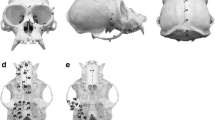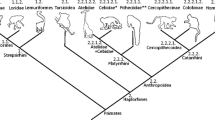Abstract
Recent analyses of amino acid sequence data from selected proteins inCavia, Rattus, Homo, Bos, Sus, and a few additional rodents and other eutherians suggested that Rodentia is not a monophyletic taxon and thatCavia and other hystricognaths may have branched off earlier than the separation between Muroidea and Primates during mammalian evolution. Because this hypothesis of polyphyly is contrary to the otherwise unanimous recognition of rodent monophyly, we have reevaluated the morphological and developmental evidence from the cranium, dentition, postcranial skeleton, and fetal membranes for the taxa Hystricognathi, Muroidea, other Rodentia, Primates, Artiodactyla, and Lagomorpha, as well as for the eutherian morphotype. Our character analyses provide strong corroboration for the traditional hypothesis of rodent monophyly and lend additional support to the suggestion that Lagomorpha is the sister taxon of Rodentia. Our survey of published molecular data furnishes little or no support for the proposed hypothesis of rodent polyphyly. We conclude that this hypothesis is the result of poor sampling of sequence data from rodents and other eutherians, rather than any inherent difficulties in the use of molecular evidence for the assessment of mammalian evolution. The available molecular data suggest thatCavia differs considerably from other hystricognaths in many proteins, but the reasons for this remain to be investigated.
Similar content being viewed by others
Literature cited
Allard, M. W., Miyamoto, M. M., and Honeycutt, R. L. (1991). Tests for rodent polyphyly.Nature 353 610–611.
Andrews, P. (1988). A phylogenetic analysis of the Primates. In Benton, M. J. (ed.),The Phylogeny and Classification of the Tetrapods, Vol. 2. Mammals, Clarendon Press, Oxford, pp. 143–175.
Beintema, J. J. (1985). Amino acid sequence data and evolutionary relationships among hystricognaths and other rodents. In Luckett, W. P., and Hartenberger, J.-L. (eds.),Evolutionary Relationships Among Rodents, Plenum Press, New York, pp. 549–565.
Beintema, J. J., and Campagne, R. N. (1987). Molecular evolution of rodent insulins.Mol. Biol. Evol. 4 10–18.
Beintema, J. J., and Lenstra, J. A. (1982). Evolution of mammalian pancreatic ribonucleases. In Goodman, M. (ed.),Macromolecular Sequences in Systematic and Evolutionary Biology, Plenum Press, New York, pp. 43–73.
Beintema, J. J., Fitch, W. M., and Carsana, A. (1986). Molecular evolution of pancreatic-type ribonucleases.Mol. Biol. Evol. 3 262–275.
Beintema, J. J., Rodewald, K., Braunitzer, G., Czelusniak, J., and Goodman, M. (1991). Studies on the phylogenetic position of the Ctenodactylidae (Rodentia).Mol. Biol. Evol. 8 151–154.
Brandt, J. F. (1855). Beiträge zur nähern Kenntniss der Säugethiere Russlands.Mém. Acad. Imp. Sci. Pétersbourg 6(9): 1–375.
Carleton, M. D. (1984). Introduction to rodents. In Anderson, S., and Jones, J. K., Jr. (eds.),Orders and Families of Recent Mammals, John Wiley and Sons, New York, pp. 255–265.
Cuvier, G. (1800–1805).Leçons d'Anatomie Comparée, 5 vol., Baudouin, Paris.
Czelusniak, J., Goodman, M., Koop, B. F., Tagle, D. A., Shoshani, J., Braunitzer, G., Kleinschmidt, T. K., De Jong, W. W., and Matsuda, G. (1990). Perspectives from amino acid and nucleotide sequences on cladistic relationships among higher taxa of Eutheria. In Genoways, H. H. (ed.),Current Mammalogy, Vol. 2, Plenum Press, New York, pp. 545–572.
De Blainville, H. M. D. (1816). Prodrome d'une nouvelle distribution systématique du règne animal.Bull. Sci. Soc. Philom. Paris Sér. 3 3 105–124.
De Jong, W. W. (1985). Superordinal affinities of Rodentia studied by sequence analysis of eye lens protein. In Luckett, W. P., and Hartenberger, J.-L. (eds.),Evolutionary Relationships Among Rodents, Plenum Press, New York, pp. 211–226.
Eisenberg, J. F. (1989).Mammals of the Neotropics. The Northern Neotropics, Vol. 1, University of Chicago Press, Chicago.
Ellerman, J. R. (1940).The Families and Genera of Living Rodents, Vol. 1, British Museum (Natural History), London.
Fitch, W. M., and Beintema, J. J. (1990). Correcting parsimonious trees for unseen nucleotide substitutions: The effect of dense branching as exemplified by ribonuclease.Mol. Biol. Evol. 7 438–443.
Friday, A. (1987). Models of evolutionary change and the estimation of evolutionary trees. In Harvey, P. H., and Partridge, L. (eds.),Oxford Surveys in Evolutionary Biology, Vol. 4, Oxford University Press, Oxford, pp. 61–88.
Gidley, J. W. (1912). The lagomorphs an independent order.Science 36 285–286.
Goodman, M., Romero-Herrera, A. E., Dene, H., Czelusniak, J., and Tashian, R. E. (1982). Amino acid sequence evidence on the phylogeny of primates and other eutherians. In Goodman, M. (ed.),Macromolecular Sequences in Systematic and Evolutionary Biology, Plenum Press, New York, pp. 115–191.
Goodman, M., Czelusniak, J., and Beeber, J. E. (1985). Phylogeny of primates and other eutherian orders: A cladistic analysis using amino acid and nucleotide sequence data.Cladistics 1 171–185.
Grassé, P.-P., and Dekeyser, P. L. (1955). Ordre des Rongeurs. In Grassé, P.-P. (ed.),Traité de Zoologie. Anatomie, Systématique, Biologie, Vol. 17(II), Masson et Cie, Paris, pp. 1321–1525.
Graur, D., Hide, W. A., and Li, W.-H. (1991). Is the guinea-pig a rodent?Nature 351 649–652.
Graur, D., Hide, W. A., Zharkikh, A., and Li, W.-H. (1992). The biochemical phylogeny of guinea pigs and gundis, and the paraphyly of the order Rodentia.Comp. Biochem. Physiol. B. Comp. Biochem. 101 495–498.
Gregory, W. K. (1910). The orders of mammals.Bull. Am. Mus. Nat. Hist. 27 1–524.
Hartenberger, J.-L. (1977). A propos de l'origine des Rongeurs.Géobios, Mém. Spéc. 1 183–193.
Hartenberger, J.-L. (1980). Données et hypothèses sur la radiation initiale des Rongeurs.Palaeovert. Mém. Jub. R. Lavocat, pp. 258–301.
Hartenberger, J.-L. (1985). The order Rodentia: Major questions on their evolutionary origin, relationships and suprafamilial systematics. In Luckett, W. P., and Hartenberger, J.-L. (eds.),Evolutionary Relationships Among Rodents, Plenum Press, New York, pp. 1–33.
Hasegawa, M., Cao, Y., Adachi, J., and Yano, T.-A. (1992). Rodent polyphyly?Nature 355 595.
Hendriks, W., Leunissen, J., Nevo, E., Blemendal, H., and De Jong, W. W. (1987). The lens protein α A-crystallin of the blind mole rat,Spalax ehrenbergi: Evolutionary change and functional constraints.Proc. Natl. Acad. Sci. USA 84 5320–5324.
Hennig, W. (1950).Grundzüge einer Theorie der phylogenetischen Systematik, Deutscher Zentralverlag, Berlin.
Hennig, W. (1966).Phylogenetic Systematics, University of Illinois Press, Urbana.
Jaeger, J.-J. (1988). Rodent phylogeny: New data and old problems. In Benton, M. J. (ed.),The Phylogeny and Classification of the Tetrapods, Vol. 2. Mammals, Clarendon Press, Oxford, pp. 177–199.
Kleinschmidt, T., Nevo, E., Goodman, M., and Braunitzer, G. (1985). Mole rat hemoglobin: Primary structure and evolutionary aspects in a second karyotype ofSpalax ehrenbergi, Rodentia (2n=52).Biol. Chem. Hoppe-Seyler 366 679–685.
Koenigswald, W. von (1985). Evolutionary trends in the enamel of rodent incisors. In Luckett, W. P., and Hartenberger, J.-L. (eds.),Evolutionary Relationships Among Rodents, Plenum Press, New York, pp. 403–422.
Li, C.-K., and Ting, S.-Y. (1985). Possible phylogenetic relationship of Asiatic eurymylids and rodents, with comments on mimotonids. In Luckett, W. P., and Hartenberger, J.-L. (eds.),Evolutionary Relationships Among Rodents, Plenum Press, New York, pp. 35–58.
Li, C.-K., Wilson, R. W., Dawson, M. R., and Krishtalka, L. (1987). The origin of rodents and lagomorphs. In Genoways, H. H. (ed.),Current Mammalogy, Vol. 1, Plenum Press, New York, pp. 97–108.
Li, C.-K., Zheng, J.-J., and Ting, S.-Y. (1989). The skull ofCocomys lingchaensis, an early Eocene ctenodactyloid rodent of Asia.Nat. Hist. Mus. Los Angeles Co. Sci. Ser. 33 179–192.
Li, W.-H., Hide, W. A., Zharkikh, A., Ma, D.-P., and Graur, D. (1992). The molecular taxonomy and evolution of the guinea pig.J. Hered. 83 174–181.
Linnaeus, C. (1735).Systema naturae, sive regna tria naturae systematice proposita per classes, ordines, genera et species, Fol. Lugduni, Batavorum.
Linnaeus, C. (1758),Systema naturae per regna tria naturae, secundum classes, ordines, genera, species cum characteribus, differentiis, synonymis, locis, Editio decima reformata, Vol. 1, Laurentii Salvii, Stockholm.
Luckett, W. P. (1977). Ontogeny of amniote fetal membranes and their application to phylogeny. In Hecht, M. K., Goody, P. C., and Hecht, B. M. (eds.),Major Patterns in Vertebrate Evolution, Plenum Press, New York, pp. 439–516.
Luckett, W. P. (1980). The suggested evolutionary relationships and classification of tree shrews. In Luckett, W. P. (ed.),Comparative Biology and Evolutionary Relationships of Tree Shrews, Plenum Press, New York, pp. 3–31.
Luckett, W. P. (1985). Superordinal and intraordinal affinities of rodents: Developmental evidence from the dentition and placentation. In Luckett, W. P., and Hartenberger, J.-L. (eds.),Evolutionary Relationships Among Rodents, Plenum Press, New York, pp. 227–276.
Luckett, W. P. (1993). An ontogenetic assessment of dental homologies in therian mammals. In Szalay, F. S., Novacek, M. J., and McKenna, M. C. (eds.),Mammal Phylogeny, Springer-Verlag, New York, pp. 182–204.
Luckett, W. P., and Hartenberger, J.-L. (eds.) (1985a).Evolutionary Relationships Among Rodents, Plenum Press, New York.
Luckett, W. P., and Hartenberger, J.-L. (1985b). Evolutionary relationships among rodents: Comments and conclusions. In Luckett, W. P., and Hartenberger, J.-L. (eds.),Evolutionary Relationships Among Rodents, Plenum Press, New York, pp. 685–712.
MacPhee, R. D. E. (1981). Auditory regions of primates and eutherian insectivores.Contrib. Primatol. 18 1–282.
Martin, R. D. (1990).Primate Origins and Evolution, Chapman and Hall, London.
McKenna, M. C. (1982). Lagomorph interrelationships.Geobios Mém. Spéc. 6 213–223.
Miyamoto, M. M., and Goodman, M. (1986). Biomolecular systematics of eutherian mammals: Phylogenetic patterns and classification.Syst. Zool. 35 230–240.
Moeller, H. (1974). Nagezähne bei Eutheria und Metatheria. Ein Beitrag zur Kenntnis von Konvergenzer-scheinungen bei Säugern.Säug. Mitt. 22 112–122.
Mossman, H. W. (1937). Comparative morphogenesis of the fetal membranes and accessory uterine structures.Contrib. Embryol. Carneg. Inst. 26 129–246.
Mossman, H. W. (1987).Vertebrate Fetal Membranes, Rutgers University Press, New Brunswick, NJ.
Novacek, M. J. (1980). Cranioskeletal features in tupaiids and selected Eutheria as phylogenetic evidence. In Luckett, W. P. (ed.),Comparative Biology and Evolutionary Relationships of Tree Shrews, Plenum Press, New York, pp. 35–93.
Novacek, M. J. (1985). Cranial evidence for rodent affinities. In Luckett, W. P., and Hartenberger, J.-L. (eds.),Evolutionary Relationships Among Rodents, Plenum Press, New York, pp. 59–81.
Novacek, M. J. (1990). Morphology, paleontology, and the higher clades of mammals. In Genoways, H. H. (ed.),Current Mammalogy, Vol. 2, Plenum Press, New York, pp. 507–543.
Prothero, D. R., Manning, E. M., and Fischer, M. (1988). The phylogeny of the ungulates. In Benton, M. J. (ed.),The Phylogeny and Classification of the Tetrapods, Vol. 2. Mammals, Clarendon Press, Oxford, pp. 201–234.
Ray, J. (1693).Synopsis methodica animalium quadrupedum et serpentini generis, S. Smith and B. Walford, London.
Romero-Herrera, A. E., Lehmann, H., Joysey, K. A., and Friday, A. E. (1978). On the evolution of myoglobin.Phil. Trans. Roy. Soc. Lond. B 283 61–163.
Sarich, V. M. (1985). Rodent macromolecular systematics. In Luckett, W. P., and Hartenberger, J.-L. (eds.),Evolutionary Relationships Among Rodents, Plenum Press, New York, pp. 423–452.
Shoshani, J. (1986). Mammalian phylogeny: Comparison of morphological and molecular results.Mol. Biol. Evol. 3 222–242.
Shoshani, J., Goodman, M., Czelusniak, J., and Braunitzer, G. (1985). A phylogeny of Rodentia and other eutherian orders: Parsimony analysis utilizing amino acid sequences of alpha and beta hemoglobin chains. In Luckett, W. P., and Hartenberger, J.-L. (eds.),Evolutionary Relationships Among Rodents, Plenum Press, New York, pp. 191–210.
Szalay, F. S. (1977). Phylogenetic relationships and a classification of the eutherian Mammalia. In Hecht, M. K., Goody, P. C., and Hecht, B. M. (eds.),Major Patterns in Vertebrate Evolution, Plenum Press, New York, pp. 317–374.
Szalay, F. S. (1985). Rodent and lagomorph morphotype adaptations, origins, and relationships: Some postcranial attributes analyzed. In Luckett, W. P., and Hartenberger, J.-L. (eds.),Evolutionary Relationships Among Rodents, Plenum Press, New York, pp. 83–132.
Szalay, F. S., Rosenberger, A. L., and Dagosto, M. (1987). Diagnosis and differentiation of the order Primates.Yrb. Phys. Anthropol. 30 75–105.
Tullberg, T. (1899). Ueber das System der Nagetiere: Eine phylogenetische Studie.Nova Acta Reg. Soc. Sci. Upsala Ser. 3 18 1–514.
Weber, M. (1904).Die Säugetiere, Gustav Fischer Verlag, Jena.
Wood, A. E. (1957). What, if anything is a rabbit?Evolution 11 417–425.
Wood, A. E. (1985). The relationships, origin and dispersal of the hystricognathous rodents. In Luckett, W. P., and Hartenberger, J.-L. (eds.),Evolutionary Relationships Among Rodents, Plenum Press, New York, pp. 475–513.
Woods, C. A. (1982). The history and classification of South American hystricognath rodents: Reflections on the far away and long ago. In Mares, M. A., and Genoways, H. H. (eds.),Mammalian Biology in South America, University of Pittsburgh Pymatuning Lab of Ecology, Linesville, pp. 377–392.
Wriston, J. C., Jr. (1981). Biochemical peculiarities of the guinea pig and some possible examples of convergent evolution.J. Mol. Evol. 17 1–9.
Author information
Authors and Affiliations
Rights and permissions
About this article
Cite this article
Luckett, W.P., Hartenberger, J.L. Monophyly or polyphyly of the order Rodentia: Possible conflict between morphological and molecular interpretations. J Mammal Evol 1, 127–147 (1993). https://doi.org/10.1007/BF01041591
Issue Date:
DOI: https://doi.org/10.1007/BF01041591




